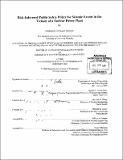| dc.contributor.advisor | George E. Apostolakis. | en_US |
| dc.contributor.author | Afolayan Jejeloye, Olubukola | en_US |
| dc.contributor.other | Massachusetts Institute of Technology. Technology and Policy Program. | en_US |
| dc.date.accessioned | 2014-04-25T15:47:39Z | |
| dc.date.available | 2014-04-25T15:47:39Z | |
| dc.date.copyright | 2002 | en_US |
| dc.date.issued | 2002 | en_US |
| dc.identifier.uri | http://hdl.handle.net/1721.1/86265 | |
| dc.description | Thesis: S.M., Massachusetts Institute of Technology, Department of Nuclear Engineering, 2002. | en_US |
| dc.description | Thesis: S.M., Massachusetts Institute of Technology, Engineering Systems Division, Technology and Policy Program, 2002. | en_US |
| dc.description | Cataloged from PDF version of thesis. | en_US |
| dc.description | Includes bibliographical references (pages 134-137). | en_US |
| dc.description.abstract | Nuclear Power Plants (NPPs) are potentially vulnerable to accidents, which can either be internally or externally initiated. External events include natural events like tornadoes, hurricanes, and earthquakes. The purpose of this thesis is to understand the characteristics of public risks arising due to a severe external event, in this case an earthquake, which affects the public both directly and via damage to a nuclear power plant. The possibility of developing a comparison basis for the risks from these two events is also investigated. Using the Seabrook Nuclear Power Plant PRA as a case study, consequences of a seismically induced nuclear risk are evaluated. Bases of comparison with direct seismic risks in Seabrook and Boston, calculated using FEMA's HAZUS program, are then analyzed. Results obtained show that the nuclear risks contribute little to the background risks from the direct earthquakes. Some consequences such as prompt fatality from the direct effect of earthquakes are 100 to 500 times bigger than the risks from the seismically induced nuclear risks at different magnitudes of earthquakes. Other consequences used for comparison include injuries and economic damage. Comparative analyses of the direct earthquake risks and the seismically induced nuclear risks present a good means of communicating the risks posed to the public. Easily understandable, these comparative analyses can be utilized in making societal decisions about risks. Based on the results from the comparisons, risk informed policies for keeping the seismically induced nuclear risks low are proposed, including keeping the ratio of the nuclear risks to the direct effect risks to a level based on societal decisions. The results and proposals obtained were presented to a panel of experts who also suggested the use of the 3-region approach in making the nuclear power plants safe. Considering events like the Turkey Point NPP experience with Hurricane Andrew, existing plans in place, such as communication and transportation after a major event, are considered. Noting that an earthquake that is strong enough to damage a NPP will affect much of the infrastructure needed to carry out emergency plans, means of strengthening the plans were evaluated. It was concluded that there has to be more cooperation among the different levels of government and the NPPs should be allowed a more active role in the policy and plan development for the safety of the public in their vicinity. | en_US |
| dc.description.statementofresponsibility | by Olubukola Afolayan Jejeloye. | en_US |
| dc.format.extent | 149 pages | en_US |
| dc.language.iso | eng | en_US |
| dc.publisher | Massachusetts Institute of Technology | en_US |
| dc.rights | M.I.T. theses are protected by copyright. They may be viewed from this source for any purpose, but reproduction or distribution in any format is prohibited without written permission. See provided URL for inquiries about permission. | en_US |
| dc.rights.uri | http://dspace.mit.edu/handle/1721.1/7582 | en_US |
| dc.subject | Nuclear Engineering. | en_US |
| dc.subject | Engineering Systems Division. | en_US |
| dc.subject | Technology and Policy Program. | en_US |
| dc.title | Risk-informed public safety policy for seismic events in the vicinity of a nuclear power plant | en_US |
| dc.type | Thesis | en_US |
| dc.description.degree | S.M. | en_US |
| dc.contributor.department | Massachusetts Institute of Technology. Department of Nuclear Engineering | en_US |
| dc.contributor.department | Massachusetts Institute of Technology. Department of Nuclear Science and Engineering | |
| dc.contributor.department | Massachusetts Institute of Technology. Engineering Systems Division | |
| dc.contributor.department | Technology and Policy Program | |
| dc.identifier.oclc | 874143798 | en_US |
